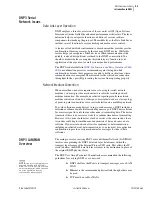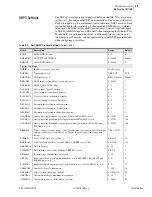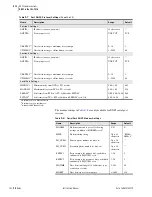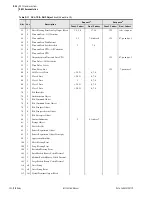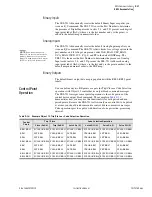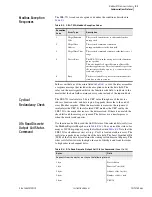
D.16
SEL-751A Relay
Instruction Manual
Date Code 20100129
DNP3 Communications
DNP3 in the SEL-751A
Scaling factors allow you to overcome the limitations imposed by the integer
nature of Objects 30 and 32. For example, the device rounds a value of
11.4 amps to 11 amps. You may use scaling to include decimal point values by
multiplying by a number larger than one. If you use 10 as a scaling factor,
11.4 amps will be transmitted as 114. You must divide the value by 10 in the
master to see the original value including one decimal place.
You can also use scaling to avoid overflowing the 16-bit maximum integer
value of 32767. For example, if you have a value that can reach 157834, you
cannot send it using DNP3 16-bit analog object variations. You could use a
scaling factor of 0.1 so that the maximum value reported is 15783. You can
then multiply the value by 10 in the master to see a value of 157830. You will
lose some precision as the last digit is rounded off in the scaling process, but
you can transmit the scaled value using standard DNP3 Objects 30 and 32.
You can customize the DNP3 analog input map with per-point scaling, and
dead band settings. Per-point customization is not required, but class scaling
(DECPLA, DECPLV, and DECPLM) and dead-band (ANADBA, ANADBV,
and ANADBM) settings are applied to indices that do not have per-point
entries. Unlike per-point scaling described above, class-level scaling is
specified by an integer in the range 0–3 (inclusive), which indicates the
number of decimal place shifts. In other words, you should select 0 to multiply
by 1, 1 for 10, 2 for 100, or 3 for 1000.
If it is important to maintain tight data coherency (that is, all data read of a
certain type was sampled or calculated at the same time), then you should
group that data together within your custom map. For example, if you want all
the currents to be coherent, you should group points IA_MAG, IB_MAG,
IC_MAG, IN_MAG, and IG_MAG together in the custom map. If points are
not grouped together, they might not come from the same data sample.
The following example describes how to create a custom DNP3 map by point
type. The example demonstrates the SEL ASCII command
SET DNP
for each
point type, but the entire configuration may be completed without saving
changes between point types. To do this, you simply continue entering data
and save the entire map at the end. Alternately, you can use
AC
SEL
ERATOR
QuickSet to simplify custom data map creation.
Consider a case where you want to set the AI points in a map as shown in
Summary of Contents for 751A
Page 1: ...20100129 SEL 751A Feeder Protection Relay Instruction Manual PM751A 01 NB...
Page 6: ...This page intentionally left blank...
Page 12: ...This page intentionally left blank...
Page 18: ...This page intentionally left blank...
Page 26: ...This page intentionally left blank...
Page 92: ...This page intentionally left blank...
Page 218: ...This page intentionally left blank...
Page 250: ...This page intentionally left blank...
Page 376: ...This page intentionally left blank...
Page 392: ...This page intentionally left blank...
Page 408: ...This page intentionally left blank...
Page 418: ...This page intentionally left blank...
Page 434: ...This page intentionally left blank...
Page 462: ...This page intentionally left blank...
Page 544: ...This page intentionally left blank...
Page 580: ...This page intentionally left blank...
Page 584: ...This page intentionally left blank...
Page 632: ...This page intentionally left blank...
Page 636: ...This page intentionally left blank...
Page 640: ...This page intentionally left blank...




